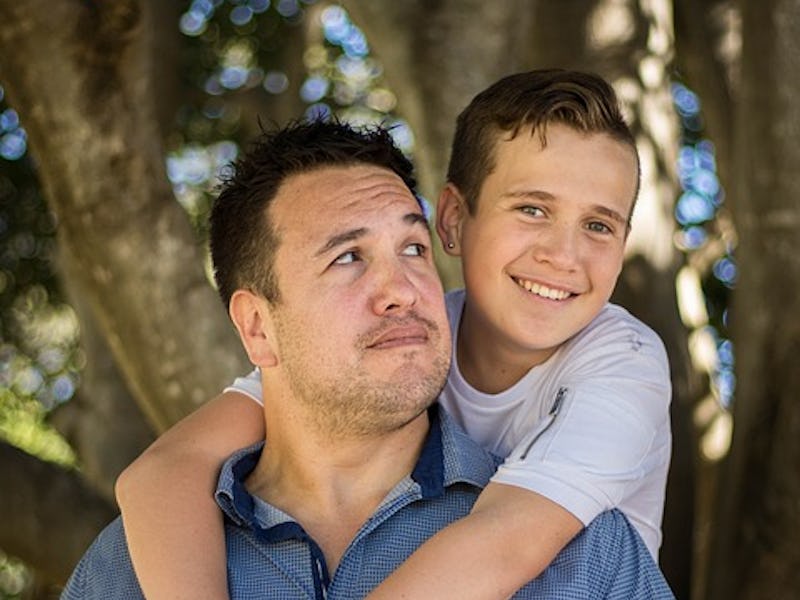"Daddy-Do-Overs" Are a Surprising New Trend in Male Plastic Surgery
"I realized I was never going to lose the weight on my own."

This Father’s Day, you could get dad something conventional. Dads like ice coolers and shaving kits; they like key finders and Bluetooth headphones too. Or, you can get him something he actually wants: Plastic surgery. According to a report released by the American Society of Plastic Surgeons on Wednesday, the “Daddy-Do-Over” is an increasingly popular Father’s Day request.
Its popularity is part of a rising trend of men wanting to go under the knife more generally. The report released by the ASPS, which represents 93 percent of all board-certified plastic surgeons in the United States, reveals that in 2018 there were 1.3 million cosmetic procedures performed on men. In 2017, there were another 1.3 million cosmetic procedures performed. These numbers represent a 29 percent increase in men seeking out plastic surgery since 2000.
Like all plastic surgery, popular male procedures can be divided into two categories: cosmetic surgical procedures and cosmetic minimally invasive procedures. The latter refers to the use of newer technologies, like injections and lasers, to produce cosmetic effects without putting patients under the knife.
In 2018, there were 200,000 cosmetic surgical procedures performed on men and the most popular choice was rhinoplasty — more commonly known as a “nose job.” Eyelid surgery ranked second, liposuction ranked third, and breast reduction ranked fourth.
A male patient receives a filler treatment.
When it came to cosmetic minimally-invasive procedures, the most common request was for Botox, which is primarily used to reduce the appearance of facial wrinkles. Approximately 100,000 men also received filler injections, which are also used to reduce signs of aging. The male use of fillers has increased by 101 percent since 2000.
“Obviously, men don’t go through the same physical changes that women experience during pregnancy and post-pregnancy, but their lifestyle does change, which can impact their appearance,” said ASPS president Dr. Alan Matarasso. “Diet and exercise patterns fluctuate, and they don’t sleep as much. Men notice their body changes due to aging and parenting, and it starts to look completely different in their 30s and 40s. That is the point of a Daddy-Do-Over.”
The Beverly Hills Center for Plastic & Laser Surgery offers a”Daddy Makeover” package that includes a variety of treatments, like under-eye rejuvenation, chin and jaw augmentation, and rhinoplasty. In an interview with Vox, plastic surgeon Dr. Douglas S. Steinbrech explained that dads are one of the groups he encounters most often:
The next iconotype — I call them my five iconotypes — is the athletic father. He hit the gym in his 20s, but in his 30s, he focused on work, got married, and had a family. He let his body go, put on 15 pounds. Now he has love handles, and that fat’s not going away, so we give him a “daddy do-over.” We take out the fat, suck it out of the lower chest, suck it out of the flanks, suck it out of the gut and put it into the shoulders, into the obliques. We bank the fat out and suck it out of the bad places to give the guy broader shoulders, a bigger chest, bigger calves, and a bigger butt.
Steinbrech credits the rise of male plastic surgery to the power of social media and increasing normalization of these procedures. Whether these procedures will result in long-term benefits for these men remains to be seen.
When it comes to determining the psychosocial outcomes of plastic surgery, studies have shown mixed results. According to a 2007 review that evaluated 36 studies on this topic, most concluded that people are “generally happy” with the outcome of their cosmetic procedures. This was particularly true for women who underwent reduction mammoplasty, used to reduce the size of breasts.
The study also found that more extensive procedures, like rhinoplasty, required greater psychological adjustment by patients compared to “restorative” procedures, like face lifts. Adjustment was necessary for patients who underwent a “serious body-image disturbance.” Unfortunately, some people are never satisfied by their cosmetic interventions because of unrealistic expectations and, in more extreme cases, body dysmorphic disorder.
When it comes to daddy-do-overs, the decision is ultimately up to the man — with the hope that he’s done his homework.
“I realized I was never going to lose the weight on my own,” said Scott, a restaurateur interviewed by the ASPS. “Plastic surgery is a personal decision, but I know guys my age who have done different cosmetic procedures. I think an open dialogue about plastic surgery is becoming more acceptable, especially for men.”